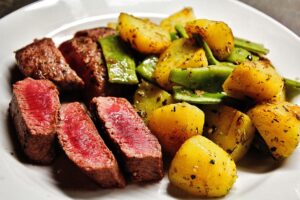Introduction
When it comes to protein content, both chicken and beef are popular choices among meat eaters. However, determining which one has more protein requires a closer look at their nutritional profiles. In this article, we will delve into the protein content of chicken and beef, comparing their values and discussing other factors that may influence protein intake.
Protein Content in Chicken
Chicken is a lean meat that is widely consumed for its high protein content. The protein content in chicken can vary depending on the cut and cooking method. On average, chicken breast is considered one of the leanest cuts and contains approximately 31 grams of protein per 100 grams (3.5 ounces) (USDA National Nutrient Database).
While chicken breast is known for its high protein content, other cuts such as chicken thighs or drumsticks may have slightly lower protein levels due to their higher fat content. However, even these cuts still provide a significant amount of protein, usually ranging between 20-25 grams per 100 grams.
Protein Content in Beef
Beef is another popular meat choice known for its protein content. Similar to chicken, the protein content in beef can vary depending on the cut and cooking method. On average, beef contains approximately 26 grams of protein per 100 grams (3.5 ounces) (USDA National Nutrient Database).
Different cuts of beef can have varying protein levels. For example, lean cuts such as sirloin or tenderloin tend to have higher protein content compared to fattier cuts like ribeye or T-bone steak. It’s worth noting that ground beef can also be a good source of protein, with approximately 25 grams per 100 grams.
Comparing Protein Content
When comparing the protein content of chicken and beef, it is evident that chicken breast generally contains more protein per 100 grams than most cuts of beef. However, it’s important to consider that individual serving sizes and personal preferences may influence the overall protein intake.
While chicken breast may have a higher protein content, beef can provide other essential nutrients such as iron and vitamin B12. Therefore, choosing between chicken and beef for protein intake should also take into account the overall nutritional needs and dietary preferences of an individual.
Other Factors to Consider
Apart from protein content, there are other factors that may influence the choice between chicken and beef. For instance, chicken is often considered a leaner meat option with lower fat content, making it a popular choice for those watching their calorie intake or aiming for weight loss. On the other hand, beef can provide a richer flavor and may be preferred by individuals who prioritize taste.
Additionally, the way these meats are prepared can also affect their nutritional value. Grilling or baking chicken and beef is generally considered healthier than frying, as it reduces the added fat content. It’s important to consider these cooking methods to ensure that the overall nutritional profile of the meat remains intact.
Conclusion
In conclusion, when comparing the protein content, chicken generally has a higher protein content per 100 grams compared to most cuts of beef. However, the choice between chicken and beef should also consider other factors such as individual nutritional needs, preferences, and overall dietary goals. Both chicken and beef can be excellent sources of protein, and incorporating a variety of protein-rich foods into a balanced diet is key to meeting daily protein requirements.
References
– USDA National Nutrient Database: https://ndb.nal.usda.gov/












